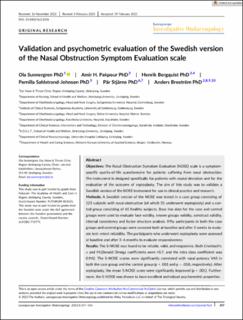| dc.contributor.author | Sunnergren, Ola | |
| dc.contributor.author | Pakpour, Amir H. | |
| dc.contributor.author | Bergquist, Henrik | |
| dc.contributor.author | Sahlstrand-Johnson, Pernilla | |
| dc.contributor.author | Stjärne, Pär | |
| dc.contributor.author | Brostrøm, Anders | |
| dc.date.accessioned | 2023-09-08T07:35:37Z | |
| dc.date.available | 2023-09-08T07:35:37Z | |
| dc.date.created | 2023-05-16T14:28:02Z | |
| dc.date.issued | 2023 | |
| dc.identifier.citation | Laryngoscope Investigative Otolaryngology (LIO). 2023, 8 (2), 357-366. | en_US |
| dc.identifier.issn | 2378-8038 | |
| dc.identifier.uri | https://hdl.handle.net/11250/3088099 | |
| dc.description.abstract | Objectives The Nasal Obstruction Symptom Evaluation (NOSE) scale is a symptom-specific quality-of-life questionnaire for patients suffering from nasal obstruction. The instrument is designed specifically for patients with septal deviation and for the evaluation of the outcome of septoplasty. The aim of this study was to validate a Swedish version of the NOSE instrument for use in clinical practice and research. Methods A Swedish version of the NOSE was tested in a case group consisting of 125 subjects with nasal obstruction (of which 31 underwent septoplasty) and a control group consisting of 65 healthy subjects. Base line data for the case and control groups were used to evaluate face validity, known groups validity, construct validity, internal consistency and factor structure analysis. Fifty participants in both the case groups and control groups were assessed both at baseline and after 2 weeks to evaluate test–retest reliability. The participants who underwent septoplasty were assessed at baseline and after 3–6 months to evaluate responsiveness. Results The S-NOSE was found to be reliable, valid, and responsive. Both Cronbach's α and McDonald Omega coefficients were >0.7, and the intra class coefficient was 0.942. The S-NOSE scores were significantly correlated with nasal patency VAS in both the case group and the control group (p < .001 and p = .018, respectively). After septoplasty, the mean S-NOSE score were significantly improved (p < .001). Furthermore, the S-NOSE was shown to have excellent and robust psychometric properties. Conclusion The S-NOSE can be recommended in both clinical practice and research to evaluate the outcome of septoplasty in Swedish-speaking populations. | en_US |
| dc.language.iso | eng | en_US |
| dc.publisher | Wiley | en_US |
| dc.rights | Attribution-NonCommercial-NoDerivatives 4.0 Internasjonal | * |
| dc.rights.uri | http://creativecommons.org/licenses/by-nc-nd/4.0/deed.no | * |
| dc.title | Validation and psychometric evaluation of the Swedish version of the Nasal Obstruction Symptom Evaluation scale | en_US |
| dc.type | Peer reviewed | en_US |
| dc.type | Journal article | en_US |
| dc.description.version | publishedVersion | en_US |
| dc.rights.holder | © 2023 The Authors | en_US |
| dc.source.pagenumber | 357-366 | en_US |
| dc.source.volume | 8 | en_US |
| dc.source.journal | Laryngoscope Investigative Otolaryngology (LIO) | en_US |
| dc.source.issue | 2 | en_US |
| dc.identifier.doi | 10.1002/lio2.1036 | |
| dc.identifier.cristin | 2147867 | |
| cristin.ispublished | true | |
| cristin.fulltext | original | |
| cristin.qualitycode | 1 | |

